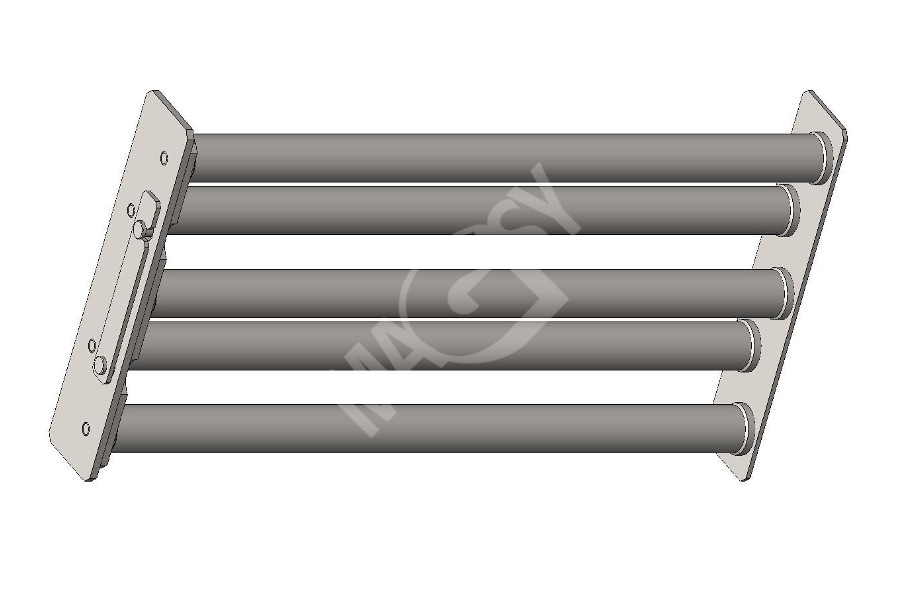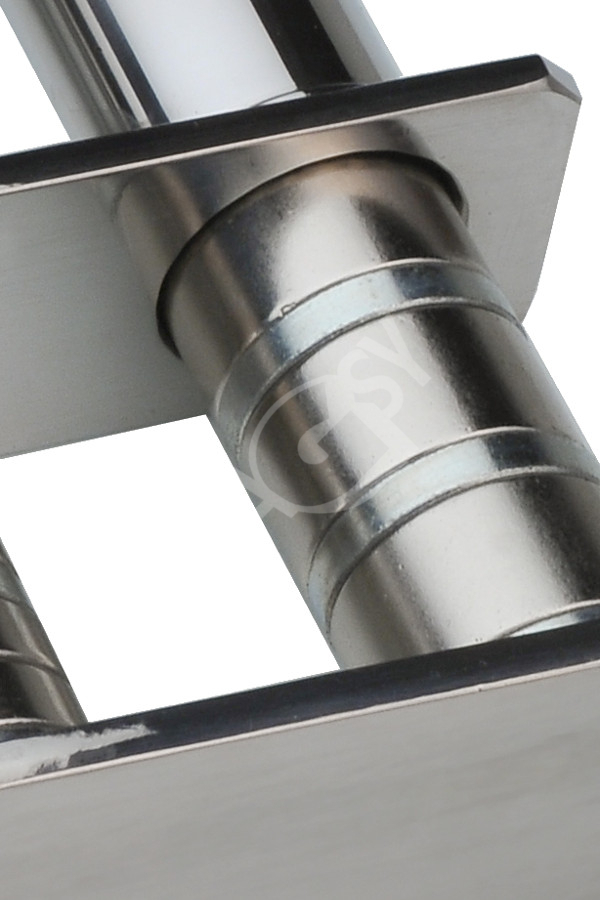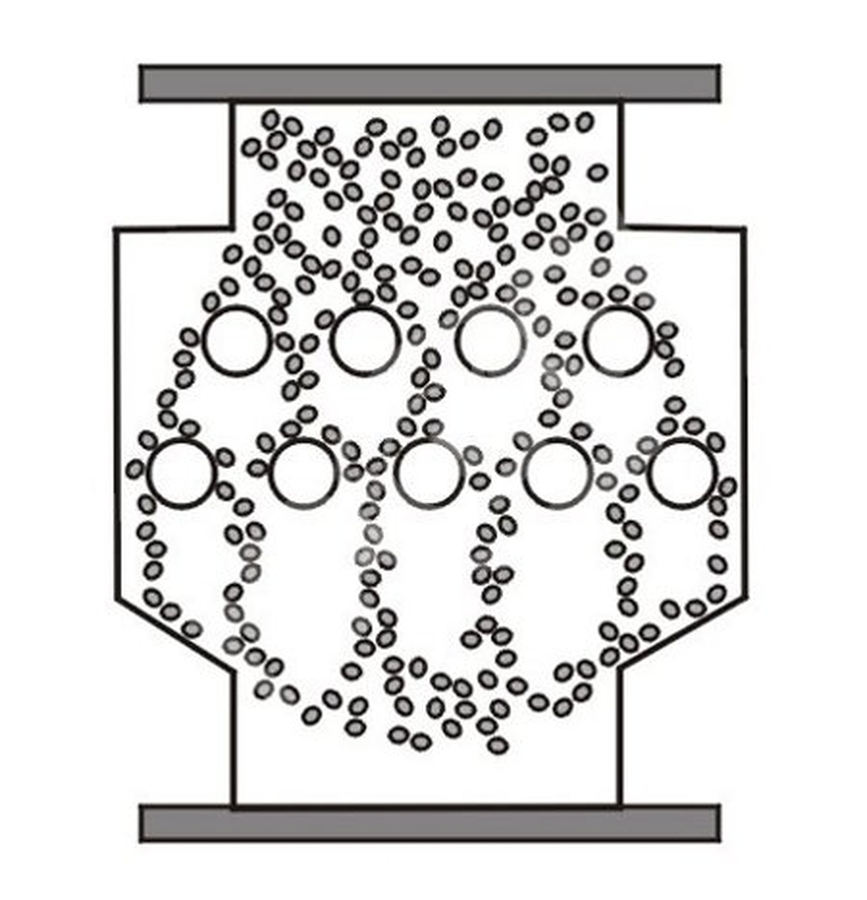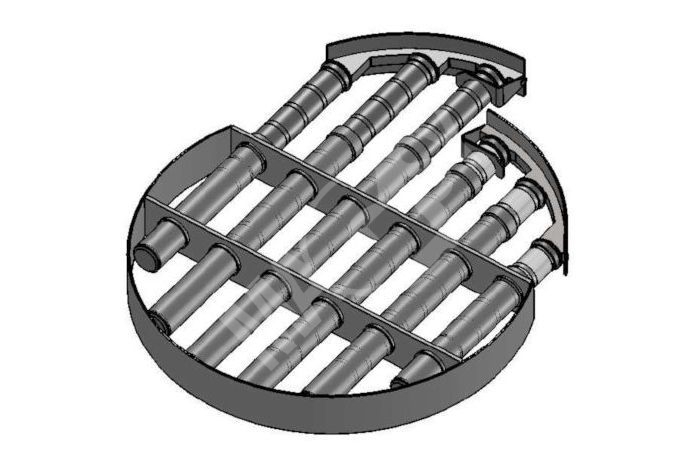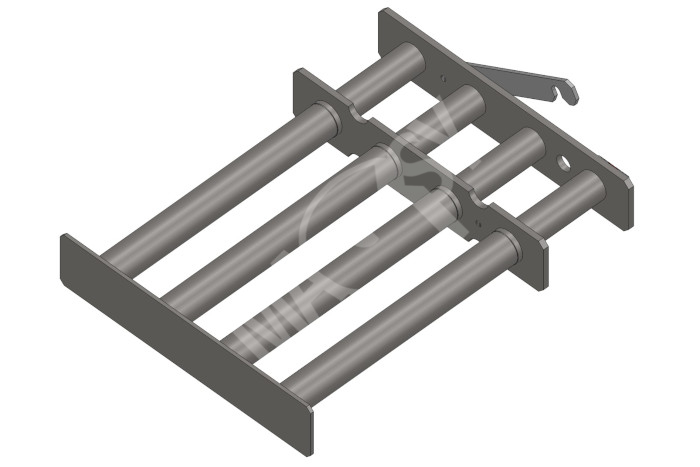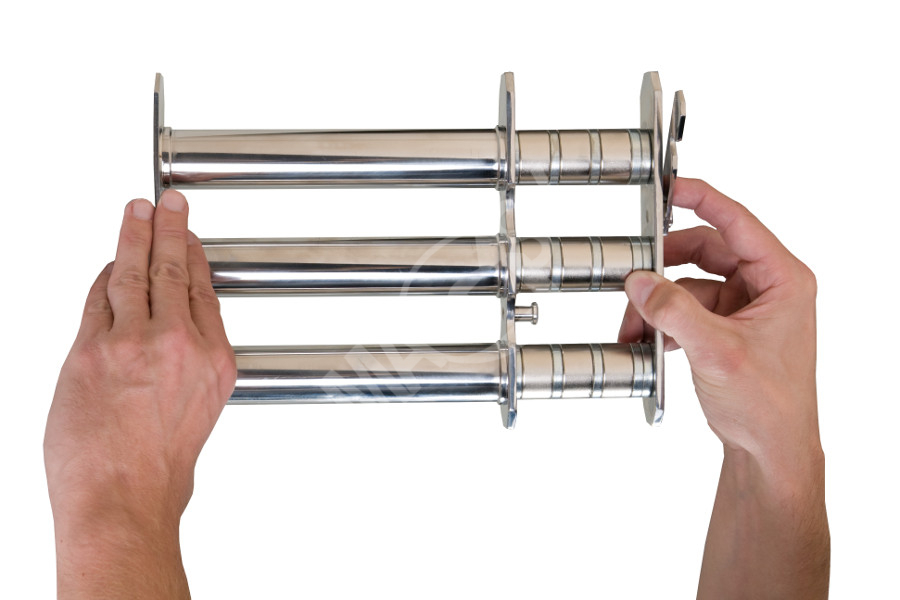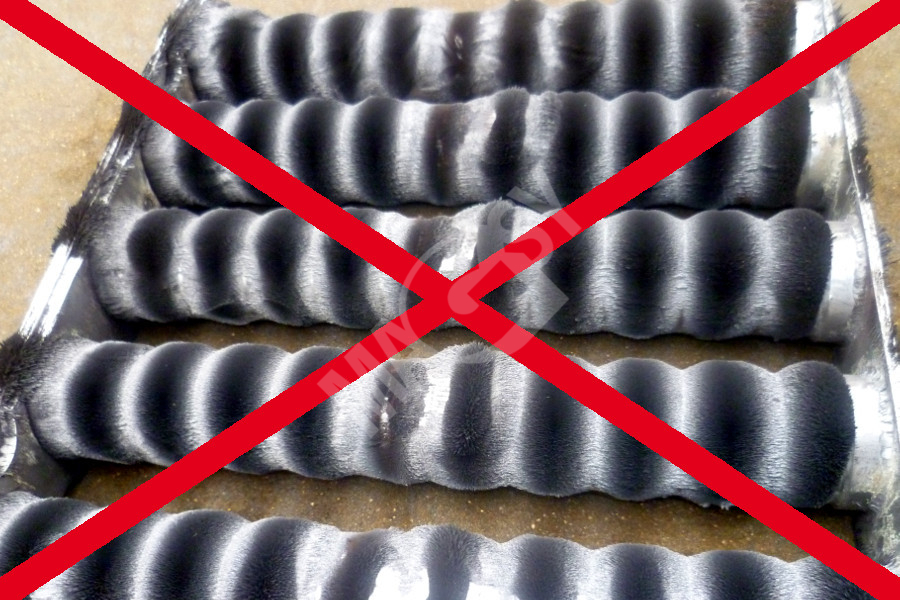-
- Dry mixtures
- Manual cleaning
- Magnetic grate with telescopic MR cores
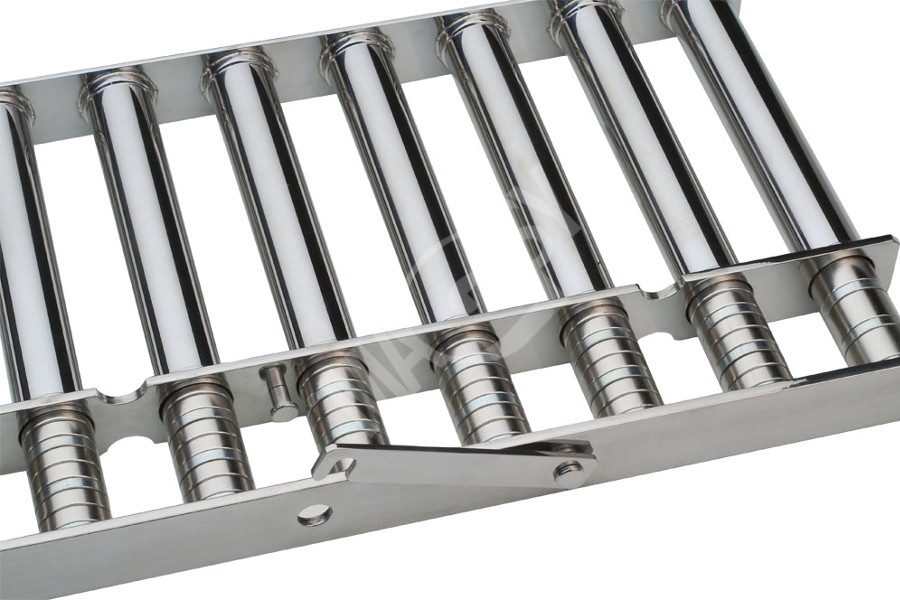
Magnetic grate with telescopic MR cores
Magnetic grate is the simplest separator type for dry, loose bulk materials. Magnetic grates form a magnetic field in which magnetic particles are induced and attracted to the surface of pipes. They remain there caught, mainly in the lower pipe part. Through the grate(s), separated medium gets using the gravitational principle, i.e. the grate is designed for the vertical material flow.
More detailed information
Independent magnetic grates are manufactured by the company MAGSY especially per order, according to dimensions given by a customer.
Size models and magnetic grate designs
As a standard, MAGSY manufactures the MR and MRD magnetic grates with the pipe diameter of 31.0 mm. As an option, per customer request, MAGSY is capable of manufacturing also grates with pipes with the diameter of 25.0 mm. Magnetic grate lengths and widths are given by customer submission requirements.
- MG grates are manufactured for the pipe sizes ranging from 100 to 400 mm.
- MGD grates are produced for the pipe sizes ranging from 100 to 150 mm, by weight reasons.
Magnetic grate utilization – industrial areas
In the separation, magnetic grate(s) is/are used in all industrial areas where a dry material is separated in small or fine fractions, with good bulk parameters.
Areas of utilization:
- Food industry, feeding product industry
- Building matter industry, ceramics, porcelain production, chemical industry
- And other industrial areas where dry, loose / bulk materials are processed
Magnetic grates are not suitable for using with abrasive agents (pipe wall is machined to a small thickness of ca 0.6 mm = fast wearing out). The same applies to materials with adhesive characteristics (grates are stationary = there is a risk of separator clogging by the reason of so called “arching” of the material).
Areas of utilization in the industrial operations:
1. Separation used to protect technologies in operations:
Technology protection separation is aimed at ferromagnetic particle removal from a medium. The purpose consists in a protection of own technological devices against damaging (cutting knives, etc.). Magnetic grate(s) is / are located within the medium processing, before the technological units that need to be protected against damaging by Fe particles. To achieve the maximum output, magnetic cores of the grates are equipped with strong NdFeB magnets. Their composition or the core assembly is made to catch medium-size, small and fine impurities (up to the size of 1.0 mm) that could damage subsequent technological units. It means that, in practice, core compositions of the levels I or II are used.
2. Product cleanliness separation:
The aim of separation is cleaning of the own product from the ferromagnetic impurities, aimed at as good as possible product cleanliness. In this case, the grate (s) is/are situated especially on the end of the production process, or within its course, on more positions. From the output point of view, grate magnetic cores are equipped with the strongest NdFeB magnets, and the magnetic core composition is designed to catch fine to the smallest impurities (starting since 1,0 µm). In practice it means that core compositions on the levels III, IV, V or VI are used.
Main benefits of MG and MGD magnetic grates:
- Good separation level – using of the strongest NdFeB magnets and lowering of the magnetic force loss by an accurate core covering pipe to the thickness of 0,6 mm at max.
- Adjustable level of the core magnetic equipment on the levels I, II, III, IV, V or VI. – a proper separation task solution as a function of operational conditions and the separation target.
- User friendly cleaning system – the system of cores capable of being pulled out of the grates provides a possibility of a comfortable and good system of the grate cleaning from Fe impurities, enabling thus reduction of operator working time losses. However, from the working safety point of view we must be careful when handling the grates and cores in the pulled out state. Not careful handling means a danger of hand finger injury.
Magnetic grate design
Magnetic grates consist of the load-bearing frame, pipe cases and magnetic core. The load-bearing frame for pipes is made of a flat profile with the thickness of 40 mm.
The pipe or the magnetic core cases are made of pulled, seamless pipes, and they are engineered to a very low thickness (ca 0.6 mm), providing magnetic output losses as low as possible. The standard MAGSY grate pipe diameter is 31.0 mm.
Grate magnetic equipment, the core
Magnetic core consists of round magnets (circular profile) and pole distances. The assembly of magnets and pole extensions is defined by carrying-away rods characteristic by a round profile. Magnetic material type and core composition are given by the requirement on the magnetic output value. At present, mostly neodymium NdFeB magnets are used for the cores. Ferrite magnetic cores have significantly lower magnetic power, so recently they are used just rarely.
Dropping labyrinth
An efficient function of all grate-type separators is based on:
- The sufficient magnetic induction (Gs) on the surface and near the grate pipes
- The high tear-off force (N) on the own grate pipe surface
- The proper, efficient dropping labyrinth of the grate pipes within a medium flow
Due to that, any impurity must be got to a contact with the magnetic pipe, or to its immediate proximity. By that reason, magnetic grates must be located on two levels located above each other at least, in order to guarantee that separate pipes of both of the grates mutually form an efficient dropping labyrinth.
Warning
Because of the fact that separate magnetic grates are supplied per order, the question of so called “dropping labyrinth” is not solved by the MAGSY side. This indispensable condition of the separation proper functioning is solved and provided by the MAGSY company only in cases of complete separators from the company portfolio (MSV, etc.)./strong>
Grate cleaning system
Magnetic grate cleaning is always manual. Both the grate frame and the core case made of pipes are manufactured using a stainless steel, in order to prevent self-magnetization.
A possibility of the core pulling out of the cases brings about an assumption of the grate de-magnetizing that is a condition of a comfortable grate cleaning from separated magnetic impurities.
Cleaning preparations and grate aids
MAGSY, as a manufacturer of separators, is strongly focused on the improvement of magnetic grate cleaning comfort. To simplify the own grate cleaning process, MAGSY produces the cleaning aids that are offered as auxiliary equipment to separator sets. Cleaning aids serve to simplify the cleaning process, improve the cleaning comfort, and also to improve the working safety on magnetic grate handling. The material: stainless steel sheet metal 1.4301.
MAGSY recommends cleaning preparation using for separator cleaning..

Cleaning preparation working steps
- Attach the grate with cores to the holder situated on the cleaning preparation (No. 1)
- After the clip (No. 2) has been released, the cores are pulled out of the grate (No. 3)
- Separate cores, pulled out of the grate, are stored in a self-contained compartment (No. 4) where they are protected against own damaging and pollution and, at the same time, they are thus secured from injury point of view.
- An independent, empty grate is then without a magnetic field, so Fe impurities leave it freely into the garbage basket. Residual impurities can be wiped-off then easily by a brush.
Cleaning preparation usage:
- cleaning comfort is increased
- improves the working safety
- increases the magnetic core lifeti
To further increase the working safety on the grate cleaning, MAGSY manufactures special cleaning aids.
General technical specification of MG, MGD magnetic grates:
Magnetic equipment
- very strong NdFeB magnets located in the covering pipes.
- As a standard: round magnet, outer diameter Ø 29 mm, pipe outer diameter Ø 31 – 32 mm
- As an option: round magnet, outer diameter Ø 24 mm, pipe outer diameter Ø 25 mm
Magnetic material temperature resistance
- As a standard: up to 80 ˚C
- As an option: up to 150 ˚C (or even higher)
Magnetic power (output)
Grate system
- Stationary grates, pulling-out magnetic cores
Dropping labyrinth
- Recommendation: magnetic grates, at least on two stages
Grate and covering pipe material
- As a standard: stainless steel 1.4301 / AISI 304.
- As an option: stainless steel 1.4404 / AISI 316L
All materials are quality-certified according to EU norms.
Surface treatment
- Grate frame: machine blasting using ceramics compound
- Outer pipe surface: machine blasting or, as an option, polishing
Connecting elements
- Designed separately by a customer
Engineered processing
All engineering operations are carried out on own machines, using own MAGSY CZ engineering technology.
Component welds
Component welds are performed according to requirements of technological norms valid for stainless steel material welding. Demanding outgoing weld quality inspection ensures the high outgoing quality.
Ask us – we will advise you!
Made-to-measure production is our strength.

